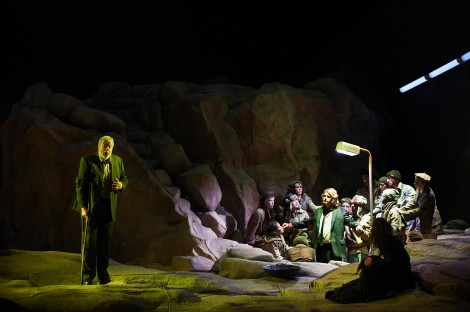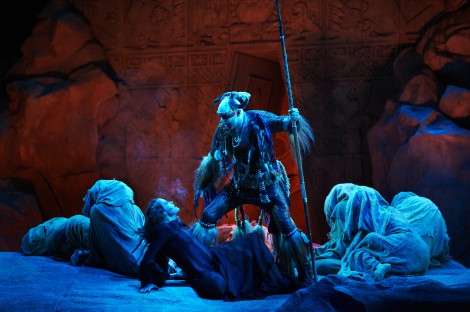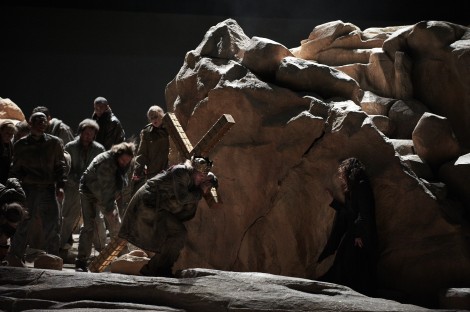24 Oct 2012
Parsifal bears its own Cross
Parsifal, with its heavy dose of religiosity and strains of racial supremacy, remains at once the most mystical and historically burdened of Wagner’s operas.

Parsifal, with its heavy dose of religiosity and strains of racial supremacy, remains at once the most mystical and historically burdened of Wagner’s operas.
As such, it is no wonder that it has yielded some of Germany’s most seminal and controversial stagings of the past decade. The late Christoph Schlingensief brought giant, rotting bunnies to Bayreuth in 2004, the original stage to which Wagner consecrated the work in 1882—leaving New Yorker critic Alex Ross “ready to hurl,” as he so candidly put it—while Stefan Herheim’s 2008 deconstructionist production for the ‘Green Hill’ becomes an allegory for German history, traveling through the world wars of the twentieth century and into the bureaucratic Federal Republic of Bonn.
Philipp Stötzl, in his new staging for the Deutsche Oper (seen at its premiere on October 21), has opted for a more conventional yet equally radical concept that foregrounds explicitly Christian imagery. The director, who worked in film before making several successful forays into opera, casts the story as a series of tableaux vivants set in a rocky mountainous region that could easily be Nazareth (sets co-designed with Conrad Moritz Reinhardt). The curtains open during the overture to a realist portrait of Jesus on the cross, surrounded by nomads and a Roman soldier. Self-flogging and fake blood abound as the procession continues, with Amfortas carrying his own cross in the final scene.
In a genius stroke that counters the lengthy nature of the opening act, Gurnemanz’s narrations about Amfortas’ seduction by Kundry and the Last Supper are depicted on the rocks in flashbacks. Parsifal, appearing in a modern black suit and tie, descends upon the scene as if walking across a film set, an effect which is accentuated by conspicuous fluorescent lighting on all sides (Ulrich Niepel). Klingsor’s magic garden is fashioned as a Mayan cave of sorts, with Native American-inspired garb for the warlock and semi-nude floral get-ups for the flower maidens (costumes by Kathi Maurer), while the final act returns to a rocky, post-apocalyptic no man’s last featuring modern-day dress and a single streetlamp under which Parsifal is anointed by a blindly fervent crowd.
 Matti Salminen as Gurnemanz and Klaus Florian Vogt as Parsifal with chorus
Matti Salminen as Gurnemanz and Klaus Florian Vogt as Parsifal with chorus
Stötzl’s episodes were for the most part expertly coordinated with the music, such as when Parsifal lunges his spear toward Amfortas’ wound, only to have the ruler grab it in an act of suicide (a gesture borrowed from Schlingensief). The director’s still lives, at their best, served to illustrate Wagner’s proto-cinematic qualities (theories point to the composer’s use of Leitmotifs and underscoring, techniques which were picked up by Hollywood starting in the silent film era, as well as the darkened theatre and continental seating in Bayreuth). The surging Liebesmahl (love feast) motif of the overture against the crucifixion scene captured the essence of Wagner’s spirit, a cry for redemption and a manic belief in the power of art to transform the senses.
Other scenes, such as the slow-moving mass of bodies wielding swords in the orchestral postlude of the final act, were nearly comical in their kitsch factor. The final act proved most perplexing in its chronological jump and aesthetic abstraction, failing to fully explain Parsifal’s anachronistic presence in the rest of the opera. It was also not clear whether the reverential raising of hands toward the grail in the final scene, including the shaking and collapsing of a man in zeal, was meant to be tongue-in-cheek. If Stötzl hoped to include an element of social critique, it was lost in the religious pageant.
 Evelyn Herlitzius, as Kundry and Thomas Jesatko as Klingsor with dancers
Evelyn Herlitzius, as Kundry and Thomas Jesatko as Klingsor with dancers
Nonetheless, his characters emerged in immediately human strokes. Klaus Florian Vogt, slowly overtaking Jonas Kaufmann as today’s most coveted Wagnerian tenor, conveyed Parsifal’s selfless naiveté with clarion tones and an unforced thespian presence. Although his high lying timbre may not conform to the vision of many seasoned Wagnerians, his sharp musicianship and natural appeal surely compensate. The baritone Thomas Johannes Mayer gave a wrenching delivery in the role of Amfortas, evoking his existential struggle without chewing the scenery and phrasing with great sensitivity.
The dark voice of veteran bass Matti Saliminen may have developed a slightly gravely quality, but he was unquestionably authoritative as the knight Gurnemanz, winning thunderous applause. Evelyn Herlitzius incarnated the wandering heathen Kundry with seductive tones, grounding large melodic leaps with a burnished low range. She was in particularly fine voice for her narrative to Parsifal, “Ich sah das Kind,” about seeing him as a baby in his mother’s arms. The bass Albert Pesendorfer was rich voiced and commanding as Amfortas’ father Titurel, and Thomas Jesatko a magnetic Klingsor. Comprimario roles were strongly cast, with Burkhard Ulrich and Tobias Kehrer standing out as the First and Second Knights of the Grail. The chorus of the Deutsche Oper brought a characteristic blend of elegant lyricism and homogeneity of tone.
 Thomas J. Mayer as Amfortas and Evelyn Herlitzius as Kundry with chorus
Thomas J. Mayer as Amfortas and Evelyn Herlitzius as Kundry with chorus
Donald Runnicles, now entering his fourth season as music director of the Deutsche Oper, led the orchestra in a smooth, strong-willed reading that did not always brim with tremendous pathos but did full justice to the soaring lines of Wagner’s score. The horns and trumpets were in top form through chromatic motifs, and although the strings’ gleaming tone did not always make its way into the transcendent, there was little doubt of the orchestra’s authentic connection to this tradition. With so many subversive productions circulating as we approach the eve of Wagner’s bicentenary in 2013, perhaps there is no need to fight the inevitable weight of history.
Rebecca Schmid